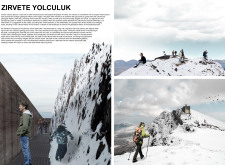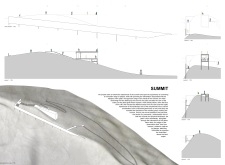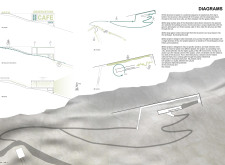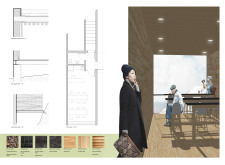5 key facts about this project
At its core, Zirve Yolculuk serves as a visitor center that invites exploration and appreciation of the volcanic landscape. The design encourages interaction with nature through a well-thought-out pathway that guides visitors from the base of the volcano to various observation points. As individuals ascend the trail, they are provided opportunities to engage with the geological features that characterize the site, fostering a deeper understanding of the region's rich history and ecological significance.
The design incorporates essential elements, with particular attention paid to the pathway and the observation deck, which act as the focal points of the project. The pathway, constructed of locally sourced gravel and quarry stone, is crafted to blend harmoniously with the surrounding landscape. This choice of materials reinforces the connection between the construction and its natural context, creating an experience that is rooted in the site's local character. The inclusion of steel railings provides structural safety while offering a modern contrast to the more organic materials.
Integral to the project is the observation deck, strategically positioned to offer unobstructed views of the volcanic crater and the surrounding vistas. The design employs large glass panels, allowing natural light to permeate the space while framing the expansive landscape outside. This transparency symbolizes an openness to the environment, inviting visitors to fully engage with the dramatic scenery.
In addition to the observation area, the design features a café that serves as a communal space for visitors and locals alike. Built with local lumber, this area is warm and welcoming, creating a comfortable environment for relaxation and social interaction. The careful selection of materials contributes to a cohesive aesthetic that respects the landscape's geological context.
Unique design approaches in Zirve Yolculuk are evident in its integration with the local community and educational components woven throughout the structure. By including informational installations, the project not only enhances the visitor experience but also promotes awareness of the geological and cultural significance of the Nemrut region. This forward-thinking approach encourages sustainable tourism practices and cultivates a sense of stewardship towards the environment.
Moreover, the project exemplifies a commitment to sustainable design through the use of locally sourced materials and energy-efficient systems. This choice reflects an architectural ethos that acknowledges the importance of environmental responsibility while enhancing the visitor experience.
Zirve Yolculuk is a noteworthy example of how architecture can serve both functional and cultural purposes. It combines thoughtful design principles with local materials, successfully creating spaces that resonate with the natural environment. As visitors make their way along the path, they not only gain insights into the geological history of the Nemrut Volcano but also foster a sense of connection to the natural world.
For those interested in understanding this project further, exploring the architectural plans, sections, and design illustrations can provide deeper insights into the thoughtful considerations and innovative ideas that underpin Zirve Yolculuk. It is an architectural endeavor that invites exploration and contemplation, highlighting the significance of place in the narrative of human experience.


























